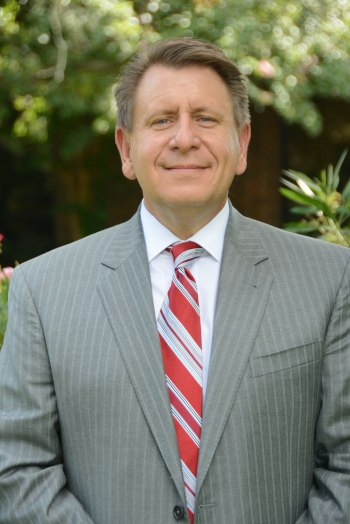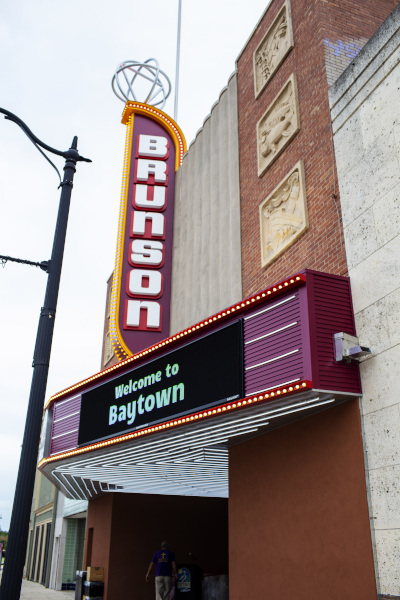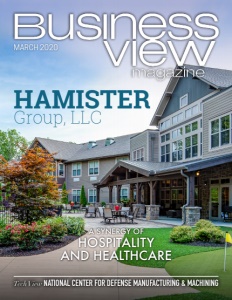Baytown, Texas
A time of significant growth
Business View Magazine interviews Rick Davis, Manager of Baytown, Texas, as part of our focus on best practices and growth of American cities.
Baytown, Texas is a city within Harris County, and partially in Chambers County, in the Gulf Coast region of the Lonestar State, and within the Houston–Sugar Land–Baytown metropolitan area. The area which became Baytown began to be settled as early as 1822, but its real nature was formed in the early 1900s, when Texas started becoming awash in oil. In 1916, the Humble Oil and Refining Company, founded by one-time Texas governor, Ross S. Sterling and his associates, built the first offshore drilling operation in Texas, and the second in the United States, in the nearby Goose Creek Oil Field.

City Manager, Rick Davis
Today, the foremost driver of Baytown’s economy is the downstream portion of the oil and gas sector. Whereas the upstream sector focuses on the production of those two fossil fuels, downstream takes what is produced and manufactures plastics and other chemicals from the raw materials. Three main corporate anchors of Baytown are ExxonMobil, Chevron Phillips Chemical, and Covestro LLC. The ExxonMobil Baytown Complex, founded in 1919, is one of the world’s largest industrial complexes, and the Baytown Refinery located there is the largest in the United States. The Covestro manufacturing site is their largest in North and Central America, producing a variety of high-tech polymer materials, and the Cedar Bayou plant, in operation since 1963, is Chevron Phillips Chemical’s largest manufacturing site in the U.S.
Over the last several years, the availability of relatively cheap and plentiful natural gas has allowed several of those major manufacturing facilities to undergo multi-billion dollar expansions. And all of that new money, with perhaps more to come, has afforded the City of Baytown the opportunity to embark upon many ambitious projects for the benefit of its citizens, estimated to be more than 90,000 residents. It’s a time of significant growth.
One such effort was the San Jacinto Boulevard Project, whose aim was to create a parallel road to the west of Garth Road, Baytown’s major commercial corridor, which had become extremely congested. “San Jacinto Blvd. is now open in all its glory and I’ve never received so many compliments for anything I’ve done in my career as that boulevard,” exclaims City Manager, Rick Davis. “It is a gorgeous, four-lane boulevard that stretches a goodly portion of the west side of our city from Interstate-10, all the way to a road called Cedar Bayou Lynchburg. Not only that, intersecting at the roundabout at Hunt Road is the beautiful statue of Sam Houston, pointing his finger toward the San Jacinto Monument, the birthplace of Texas independence.” The 15-foot-tall, 16-foot-long piece, sculpted by legendary artist David Adickes, and titled “Onward,” has Houston, the former president and governor of the Lone Star State, sitting on Saracen, his horse that was killed at the San Jacinto battlefield in 1836. “Hunt Road was also expanded and improved as part of this project and it provides a critical east/west route for us, all the way from Main Street to John Martin Street,” Davis adds.
“Also exciting about this project is the final phase – a ramp reversal project that we are executing in cooperation with the Texas Department of Transportation,” Davis continues. “That project, out on I-10, will switch the uses of an on-ramp and off-ramp. We’re going to take an off-ramp and turn it into an on-ramp, and vice versa. What this does is orient the lion’s share of eastbound I-10 traffic to San Jacinto Blvd. instead of dumping it off at Garth Road. That is critically important. I refer to the ramp reversal project as that ‘cherry on the top’ that makes San Jacinto Blvd. relevant, because now, I’ve not only connected the west side of my city to San Jacinto Blvd., I’ve also connected it with one of the largest and busiest interstates in the nation.”
As an added benefit, the ramp switch will direct more traffic to the repurposed San Jacinto Mall, “The Old San Jacinto Mall is 75 percent gone, now,” Davis reports. “The demolition of the old mall concluded in October 2019; the next phase we anticipated was the building portion in 2020, but that has always been contingent upon the developer’s ability to secure agreements from the anchors. Since last year, we have one less anchor and another one – JC Penny – we don’t really know whether they’re going to be part of the picture. But Sears is gone, officially, and their building is gone. JC Penny is negotiating, right now, with the developer to either build a new concept store or to exit this market, altogether. That would leave Macy’s. Almost all of our effort has been placed on getting the buyoff from the anchors for the development of the mall, and, in actuality, we’re seeing negotiations coming to a head.”
Meanwhile, Davis says that recruitment of secondary retailers continues to be very robust and successful. However, the scope of the project has morphed over the last several years, due to changes in the retail marketplace environment. He explains, “We are working with the developer on a different kind of concept that aligns more with a mixed-use idea – kind of a live, work, play environment – that may include a residential tower, a Class-A office tower, some very significant entertainment components, and restaurants in a village-like environment that emphasizes extreme walkability and pedestrian connectivity. It’s going to be very unique; and it’s going to align with what is, now, the 2020 retail landscape. In 2015, when we started this project, the emphasis was on getting a square foot of retail for every square foot we were demolishing over at the mall – that’s about 1.1 million square feet of retail. Retail, itself, in the wake of the apocalypse that has hit bricks and mortar over the last half decade, has caused us to change our paradigm, and we are in a mode, now, of emphasizing quality of life elements at the San Jacinto Mall. And it’s going to be called the San Jacinto Marketplace, by the way. And we’re excited because we’re now entering the finalization of the agreements with the anchors and finally the construction of retail. This will be about a three-year build-out; 2023-24 is when we expect the entire thing will be complete.”
 Another major project in Baytown is a $63-million hotel/ convention center to be built on the city-owned Bayland Island, at the base of the Fred Hartman Bridge. “This project is getting down to the very end,” says Davis. “We are at the process of selling the investment, itself, to the private market and issuing the certificates of obligation on the convention center part. This is a partnership with Garfield Public Private and a top-tier hotel flag. I’m under an NDA, so I can’t tell you who that is, but when you come over the Fred Hartman Bridge, you’re going to look at it and say, ‘How the heck did Baytown get this?’ It is a five-star hotel and it’s going to be gorgeous. We anticipate opening this by Christmas of 2021, and we are very excited about it.
Another major project in Baytown is a $63-million hotel/ convention center to be built on the city-owned Bayland Island, at the base of the Fred Hartman Bridge. “This project is getting down to the very end,” says Davis. “We are at the process of selling the investment, itself, to the private market and issuing the certificates of obligation on the convention center part. This is a partnership with Garfield Public Private and a top-tier hotel flag. I’m under an NDA, so I can’t tell you who that is, but when you come over the Fred Hartman Bridge, you’re going to look at it and say, ‘How the heck did Baytown get this?’ It is a five-star hotel and it’s going to be gorgeous. We anticipate opening this by Christmas of 2021, and we are very excited about it.
“Plus, the City of Baytown, in cooperation with a citizen committee called ‘Bring the Battleship to Baytown,’ is responding to the RFP to bring the USS Texas to port in permanent docking at the same site as the hotel/convention center on Bayland Island. The Battleship Texas is the only ship in existence now to have actively participated in both World War I and World War II. And in fact, it was present at D-Day.” At this point, the city has not yet been selected to receive the battleship, which would also have to undergo repairs in dry dock for a couple of years, before it winds up anywhere. “Delivery would not be until the fall of ’21, if we were selected,” Davis notes. “But prognosticators out there, both in the media and otherwise, have their money on Baytown. And we’d still have plenty of hurdles to scale; first of all, we’d have to show that we would have the visitorship necessary to maintain the battleship and, secondarily, we have to figure out how the dredging would be paid for in order to even get the USS Texas into our rather shallow marina.”
Downtown Baytown has also been reinvigorated over the past few years. An example of revitalization in the city’s older, southern section is Baytown’s Arts, Culture, and Entertainment (ACE) District, where the city has already invested $3.5 million in a Main Street project: building a town square in the old community of Goose Creek, one of the city’s original neighborhoods. It also recently completed the reconstruction of the Brunson Theater, a former 1949 movie house, which has now become the new Baytown Welcome Center, hosting the city’s Tourism Department, as well as an entrepreneur center.
“The movie theater on Texas Avenue is done and it is occupied,” Davis reveals. “We had a grand opening celebration at which we premiered a documentary on the Brunson Theater that soon will be available on Netflix. We tag-teamed with a production company to put that together and it features many of our citizens who had memories of that establishment. The northern half of the building not only plays host to the Tourism Division of Public Affairs, it also serves as our Welcome Center. And we’re looking into other uses for that visitor center side, perhaps even doing some educational programming, or making available some specialty advertising items bearing the city’s logo. To the south end, we have set up our entrepreneurial business center and we are in the process of finalizing that area so that it can be occupied by people who would like a hip business address in the heart of our historic district. So, we’ve preserved a very important landmark for our citizens, and it’s all ready to go.”
Two completed housing projects downtown are the Old Del Mont Hotel Building, which now has eight new residential units, and the 612 lofts, with 34 upscale apartments, located across from Lee College and next to Baytown’s Historic Oak Tree. “And they’ve been beautiful additions to our downtown area,” says Davis. “We’ve also seen some new restaurants come in – a new Mexican restaurant on Texas Ave., and a very successful ice cream establishment, as well as a Japanese restaurant. So, we are putting heads in beds and feet on the street.”
“There is also a building directly to the west of the Brunson that is an old Citizens Bank,” Davis adds. “And we have budgeted and secured the funding to renovate that building, next. At a recent Municipal Development District Board meeting, the MDD decided to back the idea of moving the City’s Utility Billing operation to the soon to be renovated Citizens Bank. That will put a lot more traffic on Texas Avenue, as well. Their current building, adjacent to City Hall, will be repurposed for other municipal use. I think it will be exciting to have utility billing and customer service over at the Citizens Bank building. Other ideas we’ve toyed with include the creation of a food hall or a restaurant incubator.
“The city is now making plans to invigorate and renovate the 100 Block. This is property the city has acquired over the years that lies directly east of Town Square. We have issued a Request for Proposals for a local restaurant to come over and occupy a building that we will build adjacent to Town Square because we want to add a restaurateur who has a proven product to the energy of Town Square. And we will build, probably, two other adjacent eateries in the future, plus an art walk, an urban play zone, and a host of other public spaces. To me, it’s an extension of Town Square. We have not launched that project yet; we’re still in the RFP and design phases, right now, but that is coming, as well.
“We also continue to implement a significant public arts program, complete with murals. We’re going to get into other art forms, as well. There’s a new concept called street painting, where you commission artists to take sections of roadway and create art out of them. It’s been done in several areas in the country, so we’re probably going to experiment with it. We’re also going to experiment with more ‘physical’ art, i.e. statues, and try to implement some things that educate as well as dazzle the eye. We continue to do our utility box wraps. This is where we take traffic cabinets and other utility electrical fixtures and wrap them with artwork. So, we’re going to let our imaginations become unleashed in the Downtown Arts District.”
Further out are two major residential projects: on the north side of town, the Friendswood Development Company has initiated construction on a 1,500 unit, 500-acre, master-planned community; and the Trinity Oaks subdivision to the south, “is rolling forward,” according to Davis. In addition, there is substantial interest from other residential developers to locate around the Grand Parkway project, a 180-mile loop around the Houston metro area, with its terminus at the Fred Hartman Bridge. “This is, probably, this region’s most significant transportation project,” Davis states. “And Baytown is very fortunate to be among the first segments to be completed by TXDOT. That highway also passes right by, and adjacent to, the Trinity Oaks project. So, needless to say, not only is there significant additional residential development interest in that area, but there is significant commercial development interest, as well, because it services all of those homes going in. So, it is exploding out there.”
As for recreational facilities in Baytown, the longtime golf course at Evergreen Park has been transformed into a 118-acre park that offers championship-caliber disc golf, beautiful scenery, and walking trails, galore. Davis notes, “We still have the driving range and the putting green; we have urban fishing, and we’re rehabilitating the old water feature that’s out there. This last year, we actually held our employee appreciation day at Evergreen, and I think it was the best employee appreciation day we’ve had since I’ve been with the city. The Evergreen Clubhouse is complete and has become one of the most demanded public meeting spaces in our city. I think it’s busy about every day. It is very elegant and it’s become very successful.”
Davis mentions two other recent city projects: In an incentive deal with Enterprise Products, a leading North American provider of midstream energy services to producers and consumers of natural gas, NGLs, crude oil, refined products and petrochemicals, Baytown will receive a pretax payment of $66 million to be put to the construction of a new 100,000-sq.-ft. Public Safety facility that will house the administrative functions of the city’s fire and police departments.
And, finally, the city has funded, and is now in the design phase of creating, a new animal control and adoption facility. “One big concern of the citizens of Baytown over the last year-and-a-half has been the treatment of animals and how well we take care of our stray animals,” says Davis. “So, that’s going to be a $7.5-million facility that will include veterinary services and provide the capability to present education programs.”
AT A GLANCE
WHO: Baytown, Texas
WHAT: A city of 77,000
WHERE: In the Gulf Coast region of the state, east of Houston
WEBSITE: www.baytown.org
PREFERRED VENDORS
Fidelis Realty Partners – www.frpltd.com
Since acquiring the San Jacinto Mall in 2015, Fidelis has worked closely with Baytown community leaders to deliver the new San Jacinto Marketplace; a destination retail and mixed-use project that will build upon Baytown’s legend with top retailers in a family-friendly atmosphere and an aesthetically pleasing environment. Baytown is a proud and thriving community, and we are confident that San Jacinto Marketplace will be too.
The upcoming San Jacinto Marketplace will be highly visible and strategically located in the heart of Baytown. This is why Fidelis is focused on bringing a wide variety of sought-after merchants, making it the premier shopping destination in the region. The Baytown community will be able to gather to enjoy dining, shopping, entertainment, and other live-work-play options in an inviting and beautiful space.
The future of San Jacinto Marketplace is bright. Fidelis continues to work diligently on the property’s progress and would like to thank Baytown’s Mayor and City Officials for working hand-in-hand to deliver results for their community. Fidelis also thanks the residents of Baytown for their patience and excitement as they build for the future of Baytown in the San Jacinto Marketplace. The second phase of demolition will begin this year!



